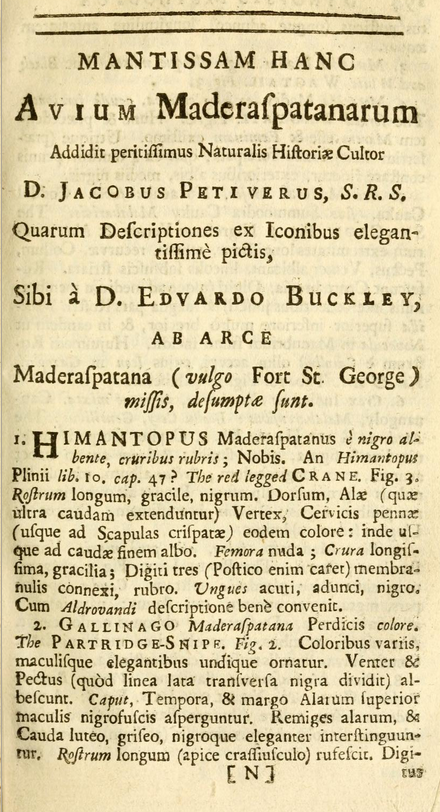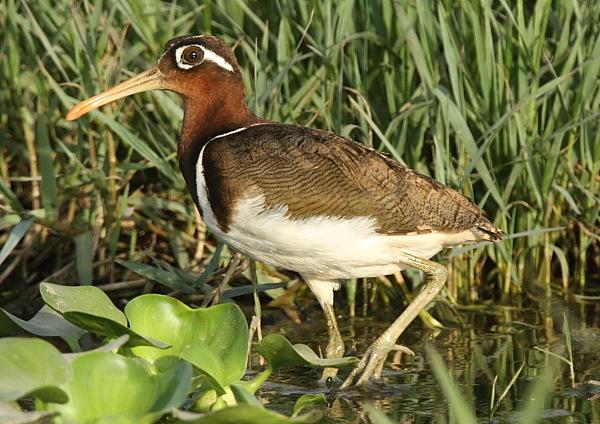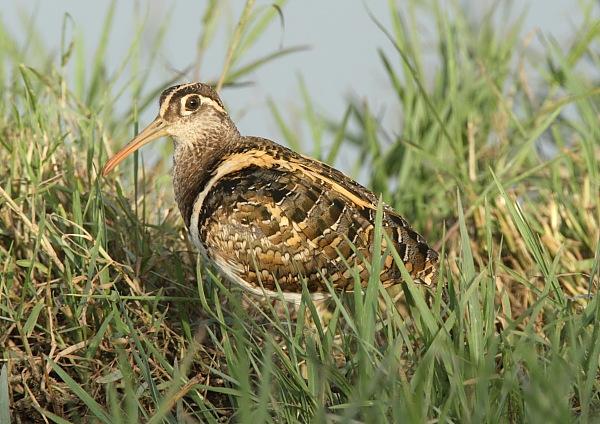One of the many treasures on
archive.org is a copy of the 1713
book
"Synopsis Methodica Avium et Piscium"
by the British scientist John Ray (or "Joannis Raii" in Latin). The book
is interesting not only because it predates and influenced Linnaean
taxonomy, but especially because it includes a few illustrations and
descriptions of "Indian birds about Fort St. George" (near Madras) at
the end, contributed by Edward Buckley, a surgeon at the Fort.

There are twenty-four captioned illustrations, most of which can be
identified easily (e.g. the Madras Sea-crow is obviously an Indian
Skimmer). But the illustrations aren't very lifelike—beaks in particular
being suspiciously similar—and some species (e.g. "Small Blue Jay" and
"Red Jay-Dove") aren't readily recognisable. Some of the descriptions
are quite detailed, however, and I tried to translate a few of them just
to see if I could identify the species involved. I meant to post some of
these translations, but never got around to it.
One of the species described is the Greater Painted-snipe Rostratula
benghalensis, which the book calls the Partridge Snipe. This is a
common species that I somehow missed seeing for many years until Hassath
and I encountered a pair in a puddle by the road at Basai. It is one of
the few species where the female has a much more striking plumage, and
is polyandrous to boot, with the offspring being raised by the male. I
was reminded of the description in the book by the lovely photographs
Sharad Sridhar sent me today.


Here's the description from the book, followed by my very rough
translation.
2. GALLINAGO Maderaspatana Perdicis colore.
The PARTRIDGE-SNIPE. Fig. 2. Coloribus variis,
maculisque elegantibus undique ornatur. Venter &
Pectus (quod linea lata transversa nigra dividit)
albescunt. Caput, Tempora, & margo Alarum superior
maculis nigrofuscis asperguntur. Remiges alarum, &
Cauda luteo, griseo, nigroque eleganter interstinguuntur.
Rostrum longum (apice crassiusculo) rufescit. Digitus
posticus (ungue adunco) longitudine anteriorem aequat.
"Gallinago Maderaspatana" is the Latin name given to the species, which
is described as "Partridge coloured" (Partridge being Perdix in
Latin). It is "decorated elegantly everywhere with spots of varying
colour". The "stomach, divided from the breast by a broad black
transverse line, becomes white", and the "head, forehead, and edges of
the upper wing are sprinkled with brown/black spots". The "flight
feathers and tail are yellow and grey with fading[?] black markings in
between", the "long beak (stout at the tip) becomes reddish", and the
"hind toe (with curved claw) is the same length as the ones in front".
(If you have a better translation, please send me email.)
It's interesting that the description obviously applies only to the male
bird. This suggests that Buckley knew the more striking-looking bird was
the female (but did not find that fact worth a mention). I'm also a bit
surprised that the very distinctive eye-marking on both sexes is not
mentioned at all. Besides, the hind toe of the female in the photograph
above seems clearly shorter than the ones in front.
(P.S. "The Red-legged Crane" in the first description on the page above
is a Black-winged Stilt, as the Himantopus suggests.)